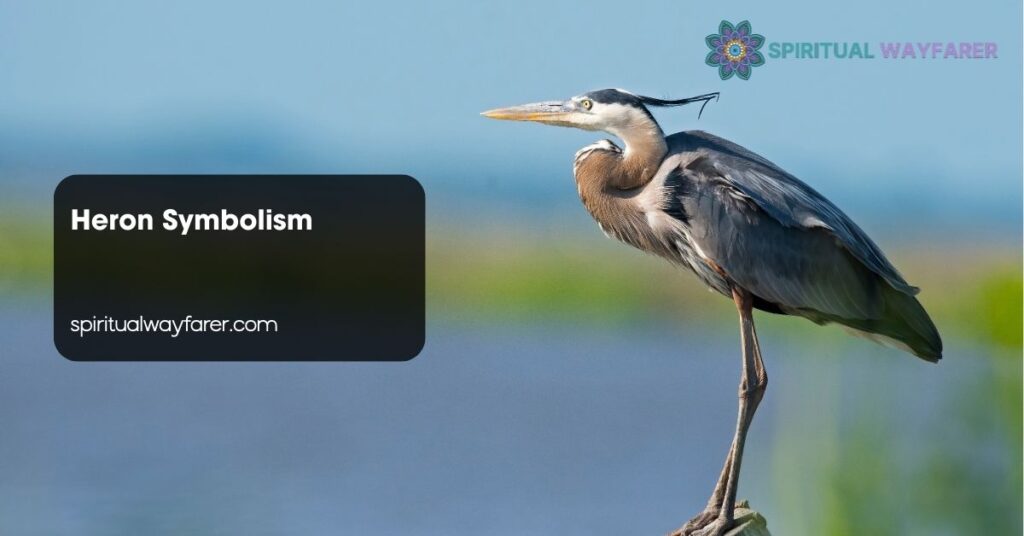The heron stands as a timeless symbol of grace and patience across various cultures. We investigate into the captivating meanings behind this elegant bird, exploring its presence in art, literature, and spiritual traditions.
By understanding heron symbolism, we unlock deeper insights into resilience and tranquility. Let’s journey together to uncover how the heron can inspire and guide us in our own lives.
From serene wetlands to majestic skies, the heron’s symbolism resonates with themes of balance and foresight. We aim to shed light on the diverse interpretations that make the heron a profound emblem in our collective consciousness.
Related Posts:
- Heron Symbolism: Explore Grace, Wisdom & Cultural Meanings
- What is the Heron Feather Meaning? Discover Symbolism & Spiritual Insights
- Heron Spiritual Meaning: Unlock the Secrets of Balance and Clarity
Understanding Heron Symbolism

We recognize the heron as a profound symbol across diverse cultures. Its grace embodies patience and perseverance, traits admired in many traditions. In artistic expressions, the heron signifies tranquility, mirroring its calm presence in natural landscapes. Literature often portrays the heron as a symbol of resilience, highlighting its ability to adapt and thrive in various environments. Our exploration into spiritual beliefs reveals that the heron represents foresight and balance, guiding us toward inner harmony. Also, the heron’s multifaceted symbolism reinforces its status as a important emblem in our collective consciousness.
Heron Symbolism in Different Cultures

Herons embody diverse meanings across various cultures, reflecting their unique beliefs and traditions.
Asian Interpretations
In Asian cultures, herons hold profound symbolic significance, particularly in Japan and China.
Japan
Japanese culture associates herons with good fortune, longevity, and purity. The white heron symbolizes peace and the dispelling of illness through the traditional white heron dance[5]. Serving as spiritual intermediaries, herons navigate air, earth, and water, bringing positive messages. Legends depict herons transforming into supernatural entities; for example, the black-crowned night heron becomes a yokai, emitting an iridescent blue glow and golden powder[5].
China
Chinese symbolism views herons as representations of transformation, longevity, and good fortune. These graceful birds are often featured in art and literature, embodying the virtues of endurance and prosperity. Herons’ elegant presence in Chinese gardens and paintings underscores their role as auspicious symbols that inspire resilience and positive change.
African Beliefs
Across African cultures, herons symbolize patience, wisdom, and adaptability. Often seen near water sources, herons represent the balance between serenity and vigilance. In some African folklore, herons are revered as messengers between the earthly area and the spiritual industry, guiding individuals through transitions and challenges. Their ability to navigate diverse environments mirrors the values of flexibility and strategic thinking upheld in many African communities.
Heron Symbolism in Literature and Art

Herons hold important symbolic meanings in both literature and art, reflecting their diverse roles across cultures and historical periods.
Literary Representations
In Greek mythology, herons act as messengers of the gods. Athena sent a heron to show her support for Odysseus in Homer’s Iliad, associating the bird with wisdom, strategy, femininity, duty, and victory. William Shakespeare utilizes heron symbolism in his plays to convey deeper meanings. For example, in Hamlet, the heron represents cowardice and the avoidance of conflict, drawing on the bird’s migration patterns and its link to southerly winds. Celtic traditions further enrich heron symbolism by connecting herons and egrets to supernatural forces, highlighting their presence in the liminal spaces between land and water.
Artistic Depictions
Artists across various cultures depict herons to embody different themes and values. In Japanese and Chinese art, herons symbolize purity, longevity, and good fortune, often appearing in traditional paintings and garden designs. European artists draw inspiration from mythological contexts, portraying herons as emblems of wisdom and strategic thinking. Contemporary art continues to celebrate herons, emphasizing their grace, resilience, and adaptability in diverse environments. These artistic interpretations reinforce the heron’s enduring presence as a powerful symbol in visual expression.
Psychological Significance of the Heron
Adaptability and Balance
The heron’s ability to navigate air, water, and land highlights its adaptability and balance. Standing on one leg, it demonstrates perfect equilibrium and self-reliance. This iconic pose encourages us to find stability in our lives, even during challenging times[1][3][5]. By observing the heron, we learn to embrace different environments and maintain our composure amidst change.
Patience and Wisdom
Patience defines the heron’s hunting technique. It remains still for extended periods, waiting for the right moment to strike prey. This behavior teaches the importance of patience and reflection in our decision-making processes. Cultivating such patience can lead to greater success and help us stay composed in various situations[1][3][5]. The heron’s calm demeanor serves as a reminder to approach life’s challenges with wisdom and thoughtful restraint.
Modern Interpretations of Heron Symbolism

Adaptability and Balance
Herons symbolize adaptability and balance through their mastery of air, water, and land environments. They demonstrate resilience by thriving in diverse settings, from wetlands to urban areas. This versatility highlights the importance of maintaining stability amidst change. By observing herons, we learn to navigate varying circumstances with poise and flexibility.
Wisdom and Patience
Herons represent wisdom and patience across multiple cultures. Their strategic hunting methods reflect deep self-reflection and determination. Calm and deliberate, herons embody the value of timing in decision-making. This symbolism encourages us to approach challenges thoughtfully, emphasizing the strength found in patience and insightful actions.
Spiritual Transformation and Growth
Herons are linked to spiritual transformation and personal growth. Their life cycle involves important changes, mirroring our own journeys of self-improvement. This connection illustrates the ability to evolve and thrive through different life stages. Embracing heron symbolism inspires us to pursue continuous development and embrace groundbreaking experiences.
Conclusion
Embracing the heron’s symbolism gives us a deeper understanding of grace and resilience. Their presence in various cultures inspires us to cultivate patience and adaptability in our lives. Reflecting on the heron’s balanced nature reminds us to seek harmony and wisdom daily. The heron’s lasting significance in art and spirituality continues to guide us toward personal growth and transformation. By integrating these symbolic lessons we navigate challenges with confidence and maintain equilibrium amidst change. The heron stands as a powerful emblem encouraging us to pursue tranquility and foresight in our journey.
Frequently Asked Questions
What does the heron symbolize?
The heron symbolizes grace, patience, and perseverance. Across various cultures, it represents resilience, tranquility, foresight, and balance. Its calm presence in natural landscapes and ability to thrive in diverse environments highlight its adaptability and enduring spirit.
How is the heron viewed in Asian cultures?
In Asian cultures, especially Japan and China, herons are symbols of good fortune, longevity, and purity. In Japan, the white heron is associated with peace and healing, while in China, herons represent transformation and prosperity, often featured in art and gardens.
What is the significance of the heron in African cultures?
In African cultures, herons symbolize patience, wisdom, and adaptability. They are seen as messengers between the earthly and spiritual realms, embodying traits that are highly valued for navigating life’s challenges and maintaining balance.
How is the heron portrayed in literature and art?
The heron is a powerful symbol in literature and art, representing wisdom, victory, and purity. In Greek mythology, it serves as a messenger of the gods, while Shakespeare uses it to convey themes of cowardice and conflict avoidance. Artistic depictions vary globally, emphasizing different symbolic meanings.
What is the psychological significance of the heron?
Psychologically, the heron represents adaptability and balance. Its ability to navigate air, water, and land symbolizes stability and self-reliance. The heron’s patient hunting technique encourages patience and thoughtful decision-making, promoting equilibrium in personal and professional life.
How does the heron symbolize modern adaptability and balance?
In modern contexts, the heron embodies adaptability and balance, thriving in environments from wetlands to urban areas. It represents wisdom and patience, reflecting strategic thinking and the importance of timing. The heron also symbolizes spiritual transformation and personal growth, inspiring continuous self-improvement.
How can the heron inspire personal growth?
The heron inspires personal growth through its symbolism of resilience, patience, and balance. By observing the heron’s strategic hunting and calm demeanor, individuals are encouraged to approach challenges with wisdom and reflection, fostering self-improvement and a harmonious life.
What role does the heron play in spiritual traditions?
In spiritual traditions, the heron acts as a messenger between the earthly and spiritual realms. It symbolizes transformation, prosperity, and purity, offering guidance and representing the connection between the physical and spiritual aspects of life.
Why is the heron considered a symbol of wisdom?
The heron is considered a symbol of wisdom due to its strategic hunting methods and thoughtful presence. In mythology and art, it is associated with gods and wise figures, embodying intelligence, foresight, and the ability to navigate complex situations with grace.
How is the heron used in contemporary art?
In contemporary art, the heron continues to be a powerful symbol, representing themes of adaptability, balance, and wisdom. Artists use the heron to convey messages of resilience and personal growth, reinforcing its status as a profound emblem in visual expression.











